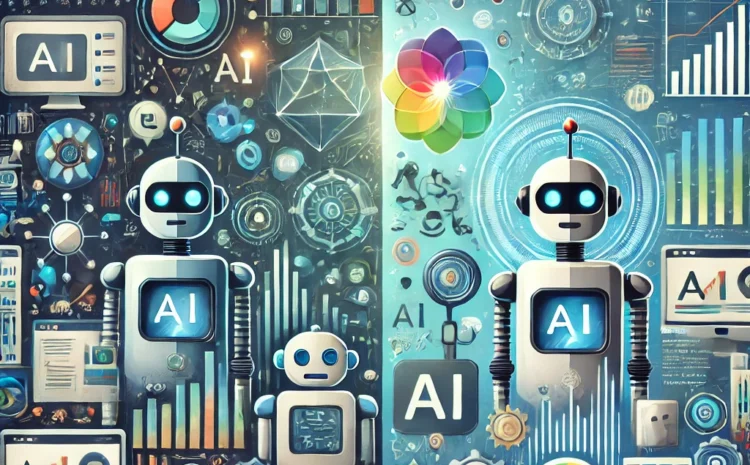The Future of Web Development and Digital Marketing: Trends to Watch in 2025
In an ever-evolving digital landscape, staying ahead of the curve is crucial for businesses looking to thrive. As we step into 2025, web development and digital marketing are undergoing rapid transformations fueled by advancements in technology and shifts in user behavior. Here are the top trends shaping the industry and how your business can benefit from them.
1. AI-Driven Development and Marketing
Artificial Intelligence (AI) continues to revolutionize both web development and digital marketing. From intelligent chatbots providing 24/7 customer support to AI tools that analyze data for more effective ad targeting, automation is reducing costs and improving efficiency.
In web development, AI-powered tools like GitHub Copilot assist developers in writing cleaner and more efficient code. On the marketing side, AI tools such as ChatGPT and Jasper are helping businesses create personalized content, conduct sentiment analysis, and optimize campaigns in real-time.
What This Means for Businesses: Leveraging AI tools can help streamline operations, personalize customer experiences, and improve overall ROI. Incorporating AI into your strategy is no longer optional but essential.
2. Voice Search Optimization
Voice search is no longer a futuristic concept; it’s now a mainstream method of finding information. With the increasing use of voice-activated devices like Amazon Alexa, Google Home, and Apple’s Siri, optimizing your digital content for voice search is more important than ever.
Voice search often relies on natural language and questions. This means businesses need to focus on creating content that mirrors conversational queries. Long-tail keywords and FAQ-style content will play a critical role in capturing this growing segment of search traffic.
What This Means for Businesses: By optimizing for voice search, you can improve your search rankings and better connect with mobile and hands-free users.
3. Progressive Web Apps (PWAs)
Progressive Web Apps bridge the gap between websites and mobile apps, offering a seamless experience across devices. PWAs are fast, reliable, and engaging, making them a preferred choice for businesses wanting to enhance user experience without the cost of developing separate apps for iOS and Android.
What This Means for Businesses: Adopting PWAs can help you provide a better user experience, reduce bounce rates, and improve customer retention.
4. The Rise of Video Content
Video remains one of the most engaging forms of content, with platforms like YouTube, TikTok, and Instagram driving massive user engagement. In 2025, the focus is shifting towards short-form, interactive, and live video content.
Interactive videos that include clickable elements or shoppable links are becoming a powerful tool for businesses to drive conversions. Additionally, live streaming creates an authentic connection with audiences, fostering trust and community.
What This Means for Businesses: Investing in high-quality, interactive video content can increase engagement and conversions while strengthening your brand identity.
5. Privacy-First Marketing
As data privacy regulations become stricter worldwide, businesses must adapt their digital marketing strategies to prioritize user privacy. Google’s phasing out of third-party cookies and the rise of data protection laws like GDPR and CCPA are reshaping how marketers collect and use data.
First-party data—collected directly from customers with their consent—is now more valuable than ever. Building trust through transparent data practices and creating compelling reasons for users to share their information is critical.
What This Means for Businesses: Developing privacy-first strategies will help you maintain customer trust while staying compliant with evolving regulations.
6. Enhanced User Experience (UX)
A seamless, intuitive, and visually appealing website is no longer a luxury; it’s a necessity. With advancements in web development technologies, including 3D elements, animations, and VR/AR integrations, the expectations for a captivating user experience are higher than ever.
Page speed optimization, accessibility compliance, and mobile-first design will remain key priorities for businesses looking to improve their online presence.
What This Means for Businesses: Prioritizing UX can significantly reduce bounce rates and improve customer satisfaction, leading to higher conversion rates.
7. Omnichannel Marketing
Consumers interact with brands across multiple platforms—websites, social media, email, and more. An integrated, consistent omnichannel approach ensures that your message resonates with your audience no matter where they encounter your brand.
From retargeting ads to personalized email campaigns, leveraging data to create a cohesive customer journey is the future of digital marketing.
What This Means for Businesses: An omnichannel strategy can help you reach your audience more effectively, increasing brand loyalty and engagement.
Final Thoughts
The web development and digital marketing landscape in 2025 is dynamic and full of opportunities. By embracing these trends, businesses can stay competitive, enhance customer experiences, and achieve measurable growth. Whether it’s integrating AI, optimizing for voice search, or prioritizing user privacy, staying informed and agile is the key to success.
Are you ready to future-proof your business? Contact us today to discover how we can help you leverage the latest trends in web development and digital marketing.











Write a Comment